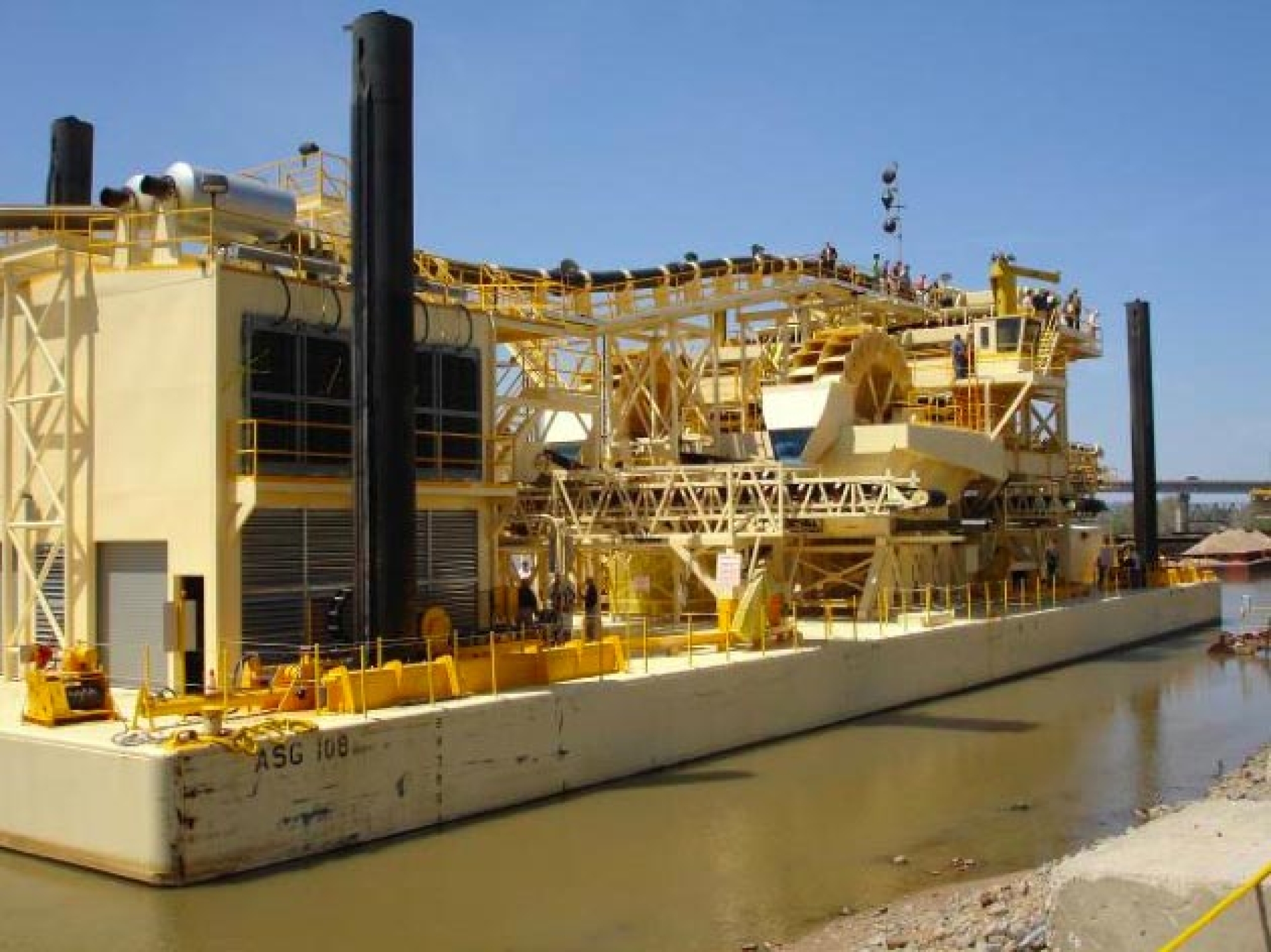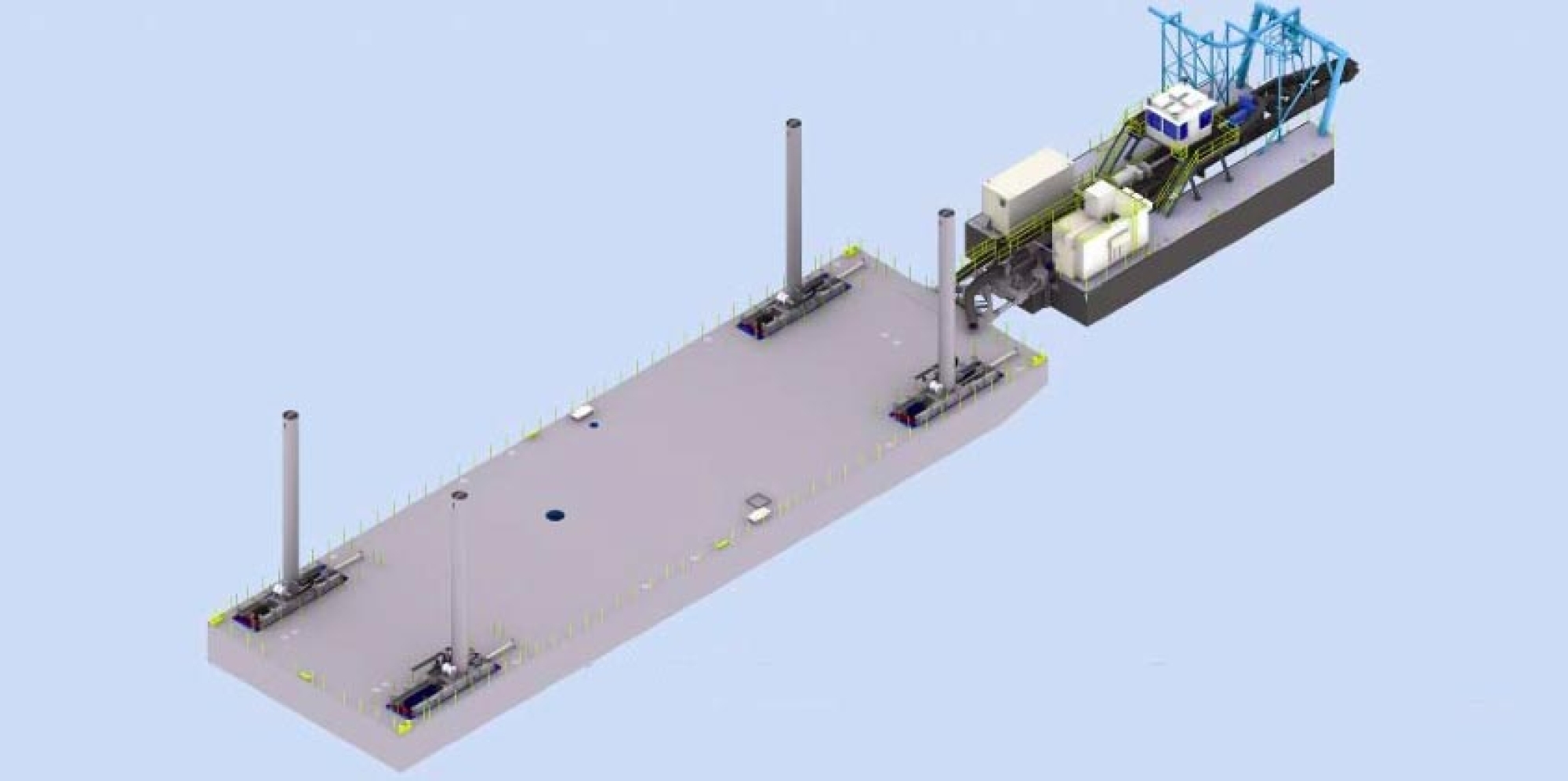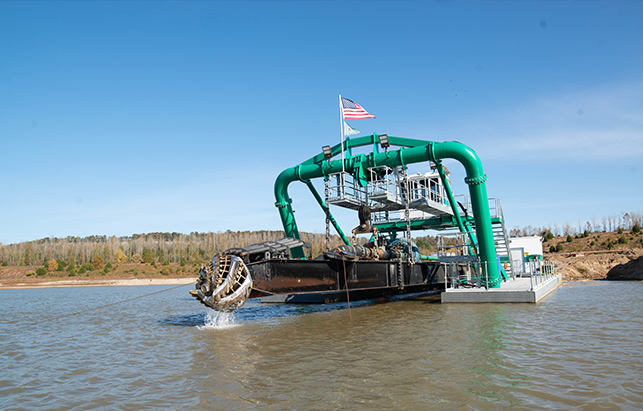The Challenge
Arkhola Sand and Gravel was using two dredges, and only could load three barges daily.
Our Solution
DSC is proud to announce the launch of a new 22-inch x 20-inch Custom Electric Marlin class, self-propelled, hydraulic cutter-suction dredge at Arkhola Sand and Gravel’s operation in Fort Smith, Arkansas. The technologically advanced barge-loading custom dredge was designed so that it could be integrated into Arkhola’s existing processing plant, while drastically increasing their overall efficiency. The new dredge will maximize production and allow for a continuous operation with no operational downtime.
The Custom Electric Marlin class dredge was designed and manufactured by DSC for Arkhola‘s Arkansas River dredging operations. Since Arkhola’s operation is very specific, the dredge was designed to incorporate its existing processing plant. In Arkhola’s operation, the material is dredged and loaded onto barges. When a barge becomes full, a tugboat takes the loaded barge to the processing area. From there, the material is blended to the customers’ specifications and loaded onto railcars for transportation directly to the customer.
Prior to delivery of the new dredge, Arkhola was using two dredges to perform this work, and on average only loading three barges per day. The new Marlin will replace both dredges, produce more than its predecessors, and load nearly three times as many barges in a day. The barge-loading process has become dramatically more efficient with Arkhola’s new system. Once a barge is fully loaded, a tugboat moves it out the way. At the same time, the plant begins to fill another barge while an empty barge is tied to the side of the plant barge, allowing for the seamless loading of barges. Production never stops, and barges are constantly loaded and transported to continue the endless process.
The dredge is designed for one-man operation from a central control room and furnished with a color touch-screen interface, allowing for simple operation. The dredge is fully automated and equipped with pump speed automation (similar to autopilot), as well as Prospector, DSC’s own GPS mine management software. Outfitted with a submerged dredge pump, the dredge is capable of digging up to 45 feet below the surface. Interestingly, areas that had already been dredged with the old dredges and were determined to be exhausted are now being re-dredged with the Marlin and are producing new material.
DSC and Arkhola worked together in designing a 60-foot x 200-foot barge to accompany the custom dredge and existing sand plant. The barge features four individually controlled spud carriages, and a pivoting, independently floating dredge front section. The aft barge contains the sand and gravel process plant equipment and serves as the dredge’s propulsion unit. Each of the four spud carriages has the capability of a 10-foot fore and aft movement. Three of the four spuds are required to hold the barge in position, while allowing one spud to reset the carriage position. This design allows the plant barge to advance through the water in a seamless movement during active dredging operations, eliminating the need to stop dredging and manually reposition the anchored cables.
Conventional dredging techniques require swing cables that are connected to manually positioned anchors. As the dredge advances, the cables need to be repositioned and anchored. This process can prove to be time consuming and inefficient for producers like Arkhola, where higher production equals increased profits. To eliminate this inefficiency, the floating front dredge is connected to the bow of the 200-foot plant barge section by a pivoting gimbal. This gimbal allows the dredge front section to swing 45 degrees to each side of the plant barge’s heading, resulting in a coverage arc of 90 degrees. Swinging of the front dredge section is accomplished by hydraulic cylinders mounted on the dredge front section and attached to the gimbal mechanism. A spill containment area located below the hydraulic swing cylinders prevents oil from entering the water in the event of a hydraulic cylinder seal failure. The dredge front section floats independently of the plant barge, allowing for a change in draft of the plant barge, while not affecting the draft of the dredge front section. This is accomplished by a horizontal link, linking the dredge front section to the barge-mounted gimbal assembly.
Since 1926, Arkhola Sand and Gravel has been operating in Fort Smith, Arkansas, and it is now expanding its services. The company dredges sand mainly from the Arkansas River. Company president Jerry Goodson says that this new addition will help Arkhola to operate more smoothly and efficiently. The barge’s design allows it to operate virtually uninterrupted, while the new higher-producing custom dredge continuously loads material onto the barges. Goodson also says that in the future, this new facility will generate more jobs in the river valley area of Fort Smith, Arkansas.
On April 14, 2009, Arkhola hosted an open house to showcase its new 22-inch x 20-inch Custom Electric Marlin Dredge. Festivities included lunch and guest speaker Arkansas Congressman John Boozman, followed by a tour of the dredge. Attending the ceremony was DSC’s Charles Johnson (Director of Sales), Damon Gonzales, P.E. (Director of Engineering), Randy Pearson (Mechanical Engineer), Jeffrey Stark (Mechanical Engineer), and Tan Nguyen (Electrical Engineer).







